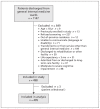Association between frailty and 30-day outcomes after discharge from hospital
- PMID: 26009583
- PMCID: PMC4527901
- DOI: 10.1503/cmaj.150100
Association between frailty and 30-day outcomes after discharge from hospital
Abstract
Background: Readmissions after hospital discharge are common and costly, but prediction models are poor at identifying patients at high risk of readmission. We evaluated the impact of frailty on readmission or death within 30 days after discharge from general internal medicine wards.
Methods: We prospectively enrolled patients discharged from 7 medical wards at 2 teaching hospitals in Edmonton. Frailty was defined by means of the previously validated Clinical Frailty Scale. The primary outcome was the composite of readmission or death within 30 days after discharge.
Results: Of the 495 patients included in the study, 162 (33%) met the definition of frailty: 91 (18%) had mild, 60 (12%) had moderate, and 11 (2%) had severe frailty. Frail patients were older, had more comorbidities, lower quality of life, and higher LACE scores at discharge than those who were not frail. The composite of 30-day readmission or death was higher among frail than among nonfrail patients (39 [24.1%] v. 46 [13.8%]). Although frailty added additional prognostic information to predictive models that included age, sex and LACE score, only moderate to severe frailty (31.0% event rate) was an independent risk factor for readmission or death (adjusted odds ratio 2.19, 95% confidence interval 1.12-4.24).
Interpretation: Frailty was common and associated with a substantially increased risk of early readmission or death after discharge from medical wards. The Clinical Frailty Scale could be useful in identifying high-risk patients being discharged from general internal medicine wards.
© 2015 Canadian Medical Association or its licensors.
Figures
Comment in
-
Frailty, thy name is Palliative!CMAJ. 2015 Nov 17;187(17):1312. doi: 10.1503/cmaj.1150074. CMAJ. 2015. PMID: 26574002 Free PMC article. No abstract available.
References
Publication types
MeSH terms
LinkOut - more resources
Full Text Sources
Other Literature Sources
Miscellaneous

